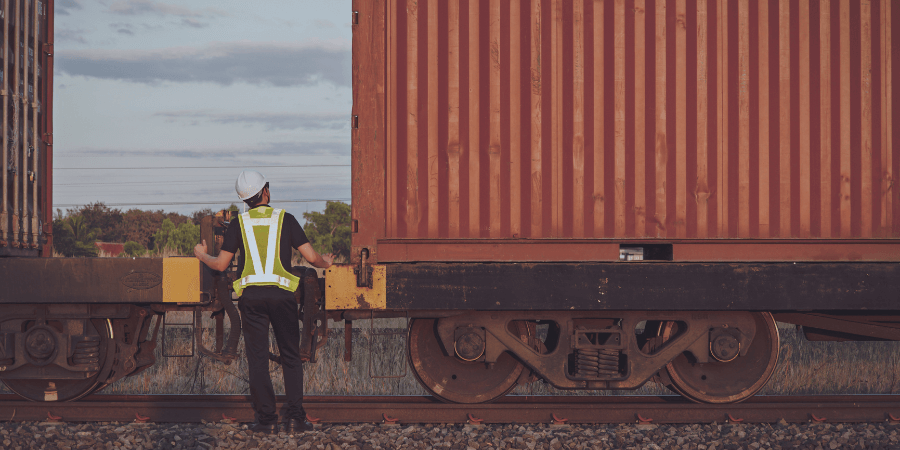
It’s slow, it’s inflexible, it’s too outdated. Do any of these sound familiar when talking to shippers about rail? Or, perhaps, are they things that you find yourself thinking about rail? We are here to tell you that these infamous rail myths are just that: myths. North American freight rail is a valuable, but nuanced industry that is continually modernizing and is crucial to the overall supply chain and economy. Dive in with us while we explore common rail folklore, and let us set the record straight.
Myth 1: Freight Rail is Limited in Scope and Flexibility
It is reasonable to think that rail is only a suitable option for certain types of business, or certain commodities. For example, industrial pipes? That makes sense to ship by rail. As do wind turbines, heavy machinery, food products, and bulk commodities. The real picture of what is suitable for rail shipments is much bigger, and much more varied than what initially comes to mind. According to the Federal Railroad Administration, shipping hazardous materials via rail is recognized as the safest land-based option for moving these products over long distances, so a wide variety of chemical products safely moves hundreds and thousands of miles across the US daily. Every year, freight rail moves about 75% of the new cars and trucks bought in the US. Going a step beyond that, intermodal shipments on freight railroads regularly contain everything from clothing and televisions that end up in big box retailers or at your front door, to Christmas trees, and even wine and cheese for your next dinner party. Take a look around wherever you are right now. Odds are, a majority of the items in your vicinity spent at least one part of their life cycle on a train.
Myth 2: Final Mile ETAs are Unreliable
Historically, it is true that visibility across rail networks has gaps that are currently being addressed in other forms of transportation. Shippers have become accustomed to receiving timely updates and real-time tracking with other shipping modes, and expect the same when using freight rail. North American freight rail encompasses nearly 140,000 miles of track, operating in 49 US states, Canada, and Mexico. There are six Class I railroads and over 600 shortlines that regularly interchange and partner. With different systems enabling different railroads, it can be difficult for any one railroad to ensure uninterrupted visibility from point A to point B. Furthermore, endpoints like ports, terminals, and transloaders often operate with different and disparate systems, further reducing data accessibility. That is why technology like Telegraph’s platform is increasingly important to ensure that operators and shippers alike have seamless visibility, to enable the best handling throughout the rail shipping journey. Having access to this technology takes an already wide-reaching industry, and makes it more accessible and easily integrated.
Myth 3: Freight Rail is Antiquated and Outdated
It is easy to conjure an image of a railroad from the 1800s – slow, chugging along, operating old equipment, maybe even a steam engine. Fortunately, this could not be further from the case when it comes to modern freight rail. It is a reliable, cost-effective transportation mode, often offering various service levels to give shippers the speed they are looking for in their supply chain. Freight railroads invest billions of dollars annually in improving and maintaining their own infrastructure, indicating readiness to manage shipments volumes with increased capacity. In fact, from 1980 to 2022, Class I railroads invested $780 billion in capital back into their networks. Additionally, railroads are constantly developing and deploying new technologies, some of which ensure that freight rail continues prioritizing safety, others which allow for more timely and streamlined communications with customers and shipping partners alike. These technological investments allow them to operate at optimal efficiency, while also improving safety metrics, resulting in a better overall shipping experience for rail customers. Furthermore, by investing in equipment like locomotives operating on alternative fuels and improved freight car designs, railroads are operating more sustainably than ever, reducing greenhouse gas emissions for shippers everywhere. In fact, shipping by rail reduces greenhouse gas emissions by up to 75%, on average. Additionally, all Class I railroads have approved measures with the Science Based Targets Initiative, and are taking additional steps to curb their emissions across rail yards, mechanical facilities, and intermodal terminals further cementing their status as the modern supply chain solution.
Myth 4: Freight Rail is not a Critical Component of our Supply Chain
For many people, railroads remain an out-of-sight, out-of-mind phenomenon that they rarely think about. In fact, unless you live in an area where you are frequently stopped at a railroad crossing, or do business in some capacity with the railroads, there is a high probability that railroads are just not something you have thought about recently. It is easy, then, to think that railroads are noncritical to not only the supply chain, but the overall US economy. In reality, over 40% of all long distance freight volume moves be rail.
An Illustrious History Meets a Modern Solution
As an almost 200-year-old industry, North American freight rail has been through many iterations. Faced with an ever-evolving landscape and consumer demand for technologies and access, freight railroads have modernized in a way that challenges all of these traditional rail myths. Freight rail is evolving, accessible, sustainable, and critical. Just as it has for the past two centuries, it will continue to serve as a vital component of US infrastructure and economic growth. To see the Telegraph platform powers the future, schedule a demo on our website!